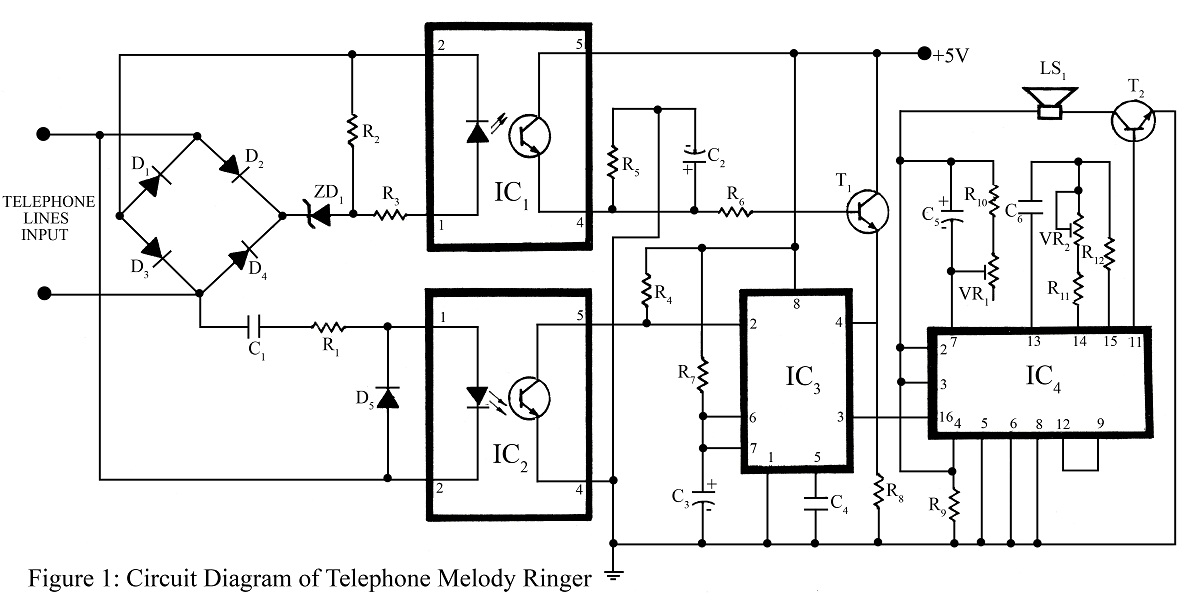
Telephone Status Indicator Circuit

This simple circuit indicates the status of a phone, including Line OK, Dialing, and Call Attended. It also features a locking mechanism to block outgoing calls while allowing incoming calls, preventing misuse of the telephone. The circuit requires only a few components to perform these functions and is directly connected to the telephone lines, eliminating the need for an external power supply. In the On Hook state, the telephone lines carry approximately 48 volts, which drops to 12 volts in the Off Hook state. Additionally, the line polarity changes during dialing and two-way communication. Capacitor C1 reduces the line voltage to a safer level for the operation of the LEDs. When the phone is Off Hook, a red LED illuminates to indicate that the lines are operational. During dialing, the red LED blinks to show the dialing status. Once the call is answered by the remote party, a green LED lights up to indicate that the call is attended. A simple toggle switch serves as the lock mechanism and can be replaced with an electrical lock with a key. When the switch is in the Off position, outgoing calls are blocked while incoming calls continue to be received as usual.
This circuit design provides a straightforward solution for telephone line status indication and call management. The use of a minimal number of components enhances reliability and ease of assembly. The direct connection to the telephone line ensures that the circuit operates without the need for an external power source, making it suitable for various applications where power availability may be limited.
The circuit operates effectively by utilizing the voltage changes associated with the telephone line's On Hook and Off Hook states. In the On Hook state, the presence of approximately 48 volts is harnessed, while the transition to the Off Hook state reduces this voltage to around 12 volts, which is suitable for the operation of the LEDs and other components. Capacitor C1 plays a crucial role in protecting the LED indicators by limiting the voltage to a safe level, thus preventing potential damage.
The visual indicators—red and green LEDs—provide clear and immediate feedback regarding the status of the phone line. The red LED serves a dual purpose: it indicates that the line is operational when Off Hook and blinks during the dialing process, signaling that a call is being initiated. The green LED confirms that the call has been successfully established once the recipient answers.
The inclusion of a locking mechanism via a toggle switch enhances the functionality of the circuit by allowing the user to prevent unauthorized outgoing calls. This feature is particularly beneficial in environments where the telephone may be at risk of misuse. The option to replace the toggle switch with an electrical lock adds an extra layer of security, making the circuit adaptable to various user needs.
Overall, this circuit design exemplifies a practical approach to telephone line management, combining functionality, safety, and user-friendly features in a compact and efficient layout.This simple circuit tells you about the status of phone such as Line OK, Dialing and Call attended. It also has a lock facility to block outgoing calls keeping the incoming calls as usual. This prevents misuse of telephone. The circuit uses only a few components to do all these jobs. The circuit is directly connected to the telephone lines and no power supply is needed. In the On Hook state, the telephone lines have around 48 volts which reduces to 12 volts in Off Hook state. More over the line polarity changes during dialing and two way speech. Capacitors C1 reduce the line voltage to a safer level for the operation of LEDs. When the phone is Off Hook, Red LED lights to indicate that the lines are OK. When a call is dialed, Red LED blinks to indicate the dialing status. When the remote person attends the call, Green LED lights indicating that the call is attended. A simple Toggle switch is provided as Lock. It can be replaced with an electrical lock with key. When the switch is in Off position, outgoing calls will be blocked but the telephone receives incoming calls as usual.
🔗 External reference
This circuit design provides a straightforward solution for telephone line status indication and call management. The use of a minimal number of components enhances reliability and ease of assembly. The direct connection to the telephone line ensures that the circuit operates without the need for an external power source, making it suitable for various applications where power availability may be limited.
The circuit operates effectively by utilizing the voltage changes associated with the telephone line's On Hook and Off Hook states. In the On Hook state, the presence of approximately 48 volts is harnessed, while the transition to the Off Hook state reduces this voltage to around 12 volts, which is suitable for the operation of the LEDs and other components. Capacitor C1 plays a crucial role in protecting the LED indicators by limiting the voltage to a safe level, thus preventing potential damage.
The visual indicators—red and green LEDs—provide clear and immediate feedback regarding the status of the phone line. The red LED serves a dual purpose: it indicates that the line is operational when Off Hook and blinks during the dialing process, signaling that a call is being initiated. The green LED confirms that the call has been successfully established once the recipient answers.
The inclusion of a locking mechanism via a toggle switch enhances the functionality of the circuit by allowing the user to prevent unauthorized outgoing calls. This feature is particularly beneficial in environments where the telephone may be at risk of misuse. The option to replace the toggle switch with an electrical lock adds an extra layer of security, making the circuit adaptable to various user needs.
Overall, this circuit design exemplifies a practical approach to telephone line management, combining functionality, safety, and user-friendly features in a compact and efficient layout.This simple circuit tells you about the status of phone such as Line OK, Dialing and Call attended. It also has a lock facility to block outgoing calls keeping the incoming calls as usual. This prevents misuse of telephone. The circuit uses only a few components to do all these jobs. The circuit is directly connected to the telephone lines and no power supply is needed. In the On Hook state, the telephone lines have around 48 volts which reduces to 12 volts in Off Hook state. More over the line polarity changes during dialing and two way speech. Capacitors C1 reduce the line voltage to a safer level for the operation of LEDs. When the phone is Off Hook, Red LED lights to indicate that the lines are OK. When a call is dialed, Red LED blinks to indicate the dialing status. When the remote person attends the call, Green LED lights indicating that the call is attended. A simple Toggle switch is provided as Lock. It can be replaced with an electrical lock with key. When the switch is in Off position, outgoing calls will be blocked but the telephone receives incoming calls as usual.
🔗 External reference





